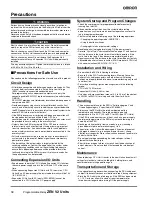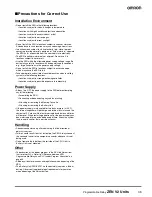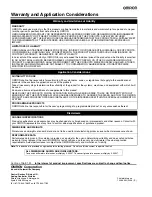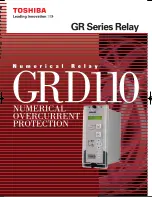
34
Programmable Relay
ZEN V2 Units
Precautions
!
WARNING
Serious human hazard may occasionally occur due to ignition or
rupture of the lithium battery used in the Battery Unit. Do not short the
battery terminals or charge, disassemble, deform under pressure, or
incinerate the battery.
Never use any battery that has been dropped on the floor or otherwise
subjected to excessive shock.
!
CAUTION
Electric shock, fire, or malfunction may occur. Do not disassemble,
modify, or repair the ZEN or touch any of the internal parts.
Electric shock may occur. Never touch the I/O terminals, computer
connector, or Battery Unit connector while power is being supplied.
Electric shock may occur. Do not remove the Expansion Unit
connector cover unless an Expansion I/O Unit will be permanently
installed.
Fire may occasionally occur. Tighten the terminal screws to a torque
of 0.565 to 0.6 N·m (5 to 5.3 in-lb).
■
Precautions for Safe Use
Please observe the following precautions for safe use of this product.
Circuit Design
•
All interface connectors and battery connectors are live parts. They
may not be directly connected to a Safety Extra Low Voltage
(SELV) circuit or to accessible conductive parts.
For programming units and personal computers use only the
connecting cable ZEN-CIF01 (optional accessory) manufactured by
OMRON.
ZEN-CIF01 provides safe (reinforced) insulation between personal
computers and ZEN.
•
Provide emergency stop circuits, external interlock circuits, limit
circuits, and other safety circuits in addition to any provided within
the ZEN control circuits to ensure safety of the overall system in the
event of ZEN failure or external factors.
•
If the ZEN discovers an error during self-diagnosis, operation will
be stopped and all outputs will be turned OFF. As a
countermeasure for such problems, external safety measures must
be provided to ensure safety in the overall system.
•
Outputs from the ZEN may remain ON or OFF due to faults in
internal circuits such as output relay fusing or burning, or output
transistor destruction. As a countermeasure for such problems,
external safety measures must be provided to ensure safety in the
overall system.
•
Fail-safe measures must be taken by the user to ensure overall
system safety in the event of broken signal lines or momentary
power interruptions.
•
The durability of the output relays is largely affected by the
switching conditions. Confirm the operation of the system under
actual operating conditions and set the switching frequency to
ensure that adequate performance will be provided. Insulation
faults and burning in the ZEN may result if relays are used after
their performance has deteriorated.
Connecting Expansion I/O Units
•
Supply power to both the CPU Unit and Expansion I/O Units from
the same power supply and turn them ON and OFF at the same
time.
•
When connecting Expansion I/O Units with DC inputs to a CPU
Unit with an AC power supply, the burst noise immunity will be 1 kV
(IEC 61000-4-4).
•
Expansion I/O Units with AC inputs (ZEN-8E1AR) cannot be
connected to a CPU Unit with a DC power supply.
System Startup and Program Changes
•
Check the user program for proper execution before actually
running it on the Unit.
•
Disconnect the output lines from the system before testing
operation in any system in which incorrect operation can result in
injury or equipment damage.
•
Confirm safety before attempting any of the following operations.
•
Changing the operating mode (RUN/STOP).
•
Using the button switches.
•
Changing bit status or parameter settings.
•
Double-check all wiring before turning ON the power supply.
•
Refer to
“Cycle Time Calculation Method”
on page 21 and confirm
that the increase in the cycle time will not affect operation. If the
cycle time is too long, it may become impossible to read input
signals accurately. The increase in the cycle time will be particularly
noticeable when set values are written in RUN mode for a CPU Unit
with communications (ZEN-10C4
@
R-
@
-V2).
Installation and Wiring
•
Do not allow the ZEN to fall during installation.
•
Be sure that the DIN Track mounting levers, Memory Cassettes,
Battery Units, cable connectors, and other items with locking
devices are properly locked into place. Improper locking may result
in malfunction.
•
For surface mounting, tighten mounting screws to the following
torque.
CPU Units: 1.03 N·m max.
Expansion I/O Units: 0.46 N·m max.
•
Use wires with cross-sectional areas of 0.2 to 2.5 mm
2
(equivalent
to AWG24 to AWG14) for wiring and strip them for 6.5 mm.
Handling
•
The environment of use for the ZEN is "Pollution degree 2" and
"Overvoltage category II" specified in IEC60664-1.
•
Always use the ZEN within the rated ambient operating
temperature and humidity. The rated ambient operating
temperature is 0 to 55
°
C (
−
25 to 55
°
C for LED-type CPU Units).
If the ZEN is used near sources of heat, such as a power supply,
the internal temperature of the ZEN may increase, lowering the
durability of the ZEN.
•
Discharge static electricity from your body, e.g., by touching a
grounded metal plate, before touching any Unit.
•
The exterior of the Units will be damaged if it comes into contact
with organic solvents (e.g., benzene or paint thinner), strong
alkalies, or strong acids. Never allow such substances to come into
contact with the Units.
•
Do not apply voltages exceeding the rated voltages. Internal
elements may be destroyed.
•
Short failures or open failures may result from the destruction of
output elements. Do not use loads that exceed the rated output
current.
Maintenance
When replacing a CPU Unit, transfer to the new Unit and confirm all
settings for clock data, internal holding bits, holding timers, and
counters before starting operation again.
Transportation and Storage
•
Use special packing boxes when transporting the ZEN and do not
subject it to excessive shock or vibration or drop it during shipment.
•
Store the ZEN within the rated ranges. If the ZEN has been stored
at
−
10
°
C or lower, allow it to stand at room temperature for
three hours or longer before turning ON the power supply.



































